CompTIA's IT Opportunities in the Education Market study consists of four sections, which can be viewed independently or together as chapters of a comprehensive report.
Section 1: Education Market Background, Technology Attitudes and Priorities
Section 2: Education Technology Usage and Adoption
Section 3: Education Technology Practices, Demand Drivers and Obstacles
Section 4: Education Technology Satisfaction Levels
To view other sections of this report please go to the research page on the CompTIA website.
The data for this study was collected via a quantitative online survey of 500 U.S. educators and administrators. The sample consists of 353 primary school/K-12 educators and staff and 147 higher education employees that make decisions and influence the use of technology in their institutions.
Nearly three-quarters of the respondents Identified as teachers, Instructors or administrative (deans, principals, etc.), while the remaining quarter Included staff and IT personnel. Data collection occurred during February 2011.
The margin of sampling error at the 95% confidence level for the overall results is +/- 4.5 percentage points. Sampling error is larger for subgroups of the data, such as K-12 or university level results. As with any survey, sampling error is only one
source of possible error. While non-sampling error cannot be accurately calculated, precautionary steps were taken in all phases of the survey design, collection and processing of the data to minimize its influence.
CompTIA is responsible for
all content contained In this series. Any questions regarding the study should be directed to CompTIA Market Research staff at [email protected].
CompTIA is a member of the Marketing Research Association (MRA) and adheres to the MRA's Code of Market Research Ethics and Standards.
Technology's impact on today's schools has been significant, advancing how students learn, how teachers teach and how efficiently and effectively services can be delivered to schools and universities. And with emerging technologies such as tablet PCs, interactive whiteboards and wireless solutions gaining ground in the classroom, the reliance on IT by the education market will only grow in the years ahead. That translates into serious opportunities for IT vendors and the channel.
CompTIA's four-part report series, IT Opportunities in the Education Market, provides insights into the education market's use, consumption and purchase plans for technology, with the goal of outlining the tech industry opportunity from the perspective of actual educators.
First off, let's take a look at the education market as a whole. Broadly speaking, the U.S. education market is comprised of two segments: K-12 schools (kindergarten through 12 grade of high school) and higher education institutions (colleges, universities, etc.). Gartner pegs total worldwide IT spending on education, at $64 billion, but the addition of telecom services spending, which is excluded in Gartner's number, pushes total IT spend in the education market much higher. In the United States, IT spending at the higher education level was $12.1 billion, while ringing in at $9.1 billion in K-12 schools.
Market research firm IBISWorld estimates there are 33,509 K-12 schools in the United States in 2011, serving 56 million public and private school students. The total number of students is projected to increase to 59 million by 2016, according to IBIS. These numbers do not capture the estimated 2 million additional students in the united States who are homeschooled, according to the National Center of Education Statistics. It is important that the homeschooled population not be overlooked in the context of technology spending and services since many school districts must maintain some form of online collaboration and communications ties to this group in order to provide curriculum resources and, in some cases, track educational progress.
At the higher education level, the U.S. Dept. of Education reports a record 19.1 million students enrolled in two- or four-year colleges and universities in the fall 2010, an increase of about 3.8 million since fall 2000.
In addition to the number of students, public schools employ roughly 3.3 million teachers as of fall 2010, according to the U.S. Dept. of Education. Classroom teachers wield tremendous influence in terms of technology adoption in the classroom, albeit to the extent that funding is in place to support their IT requests. Consider the following, however: 58% of K-12 teachers said they either make the final technology purchasing decisions for their classrooms or that they recommend and influence the final decisions, according to the CompTIA study.
On a down note, federal spending on education is among those budget line items that is expected to take hit in the 2012 fiscal year. Spending cuts at the federal level trickle down to the state coffers and inevitably will impact how individual schools allocate their remaining resources, including dollars spent on technology. For more details, Section 3 in the CompTIA report series highlights the obstacles educational institutions say impede adoption of technology, and among the chief culprits they cite are budget cutbacks or freezes.
The CompTIA study found sentiment to be largely positive when it comes to the adoption and use of technology in schools at both the K-12 and higher education levels. Nearly two-thirds of respondents said they believed that students today are more productive than they were three years ago as a direct result of the use of technology. That dovetails with what more than half (56%) of respondents cited as their No. 1 priority for using technology: The desire to improve student performance.

K-12 and higher education do exhibit some differences in how they approach, adopt and utilize IT solutions. For example, 43% of K-12 teachers strongly agreed that they were eager to deploy new technologies into their classrooms, while just 23% of higher education instructors expressed a similar level of zeal. One reason for this might be the fact that the structure of many K-12 schools is such that teachers take ownership in many ways to one particular physical classroom; it is essentially theirs for the school year and they shepherd how it is set up, what tools are used etc. In the higher ed world, classrooms typically are more sterile (think lecture hall layout) and less the domain of individual professors, who instead maintain private offices.
How respondents perceived their institution's approach to technology correlated to their individual attitudes about technology in some cases. For example, respondents who reported that their school was an "early adopter" of technology were more likely to strongly disagree with statements such as "Technology moves too fast" or "I view many IT expenditures as a necessary evil that don't really enhance the student or instructor experience or performance" than those who characterized their schools as middle or late adopters of technology. A quarter of early adopter respondents strongly disagreed that tech moves to fast, compared with 14% of middle adopters and 12% of late adopters. As for considering IT expenditures a necessary evil, 43% of early adopters strongly disagreed with that position, compared with 28% and 26% of middle and late adopters, respectively. Generally speaking, most respondents across both K-12 and higher ed described their institutions as middle adopters of technology. This lines up with how many executives in the private sector corporate market describe their organizations.
There are other differences between K-12 and higher education with respect to their priorities for technology usage, though generally speaking they align similarly. What stands out is the fact that just 23% of higher education respondents considered their institutions early adopters of technology. This would seem to buck conventional thought that colleges and universities are hotbeds for technology innovation and adoption — think the roots of the Internet. And as other data bear out in this study, higher ed institutions are more likely to have adopted emerging technologies, among them tablet devices, than K-12. However, one like explanation for the low early adopter perception might come back to budget shortfalls and the fact that universities are to some degree like large enterprise corporations, where IT purchases must wend their way through a labyrinth of IT and purchasing departments and are subject to the bidding process.
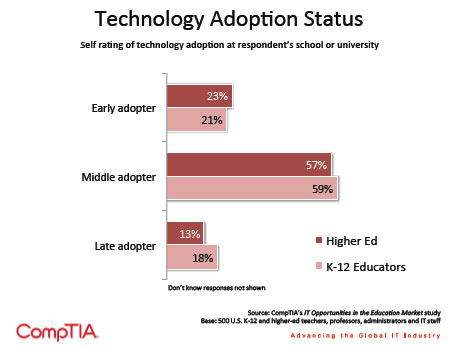
K-12 educators, for example, place a higher priority on improving student performance (64% do versus 38% for higher ed) and boosting productivity relative to higher education respondents (46% versus 38% for higher ed), for example. In contrast, higher education instructors place relatively greater importance on remote access to data and knowledge management (34% versus 21% of K-12).
As mentioned above, respondents in general (56%) said improving student performance was their chief priority in the use of technology. This is hardly surprising and in fact correlates to another CompTIA study, CompTIA 2 Annual HIT Insights, which surveyed doctors and other medical professionals about technology. Asked their priorities for the use of technology, and the vast majority (77%) cited improving patient care.
Other priorities differ across the various types of schools. Among the smallest schools (<$5 million operating budget), for example, just 18% said the ability to access data remotely was a priority driving technology adoption, while more than a third of the largest institutions ($100 million operating budget) rated it a priority. This makes sense given that the smallest schools tend to be self-contained, while larger entities are made up of multiple buildings, campuses and a larger student population, creating a situation where mobility and remote access are paramount.

When it comes to emerging technologies, generally half of K-12 educators and administrators said they are interested in using some of the cutting-edge solutions available on the market today, including e-learning tools for remote students, tablet PCs, e-readers and audio augmentation systems for the classroom.
Not surprisingly, early adopters schools (63%) were the most thrilled by the possibility of using tablet devices and netbooks, while 38% expressed interest in e-readers/e-books.
And yet, significant numbers of educators still are not yet excited about emerging technologies, based on the survey results. This could be explained by budget shortfalls that have hamstrung institutions to the point that users dismiss thoughts of buying and implementing some of the newer technology solutions aimed at the education market today. Call it a situation of cautious expectations.
Among some of the newer technology solutions available today, more than half (56%) of K-12 teachers were most excited about the educational possibilities of using interactive whiteboards in the classroom, while half are jazzed about deploying netbooks and/or tablet PCs. Just 8% expressed excitement over the use of audio augmentation systems, perhaps because it is often viewed as a technology that's nice to have, but not necessary, especially in K-12 classrooms that physically speaking are not typically very large.
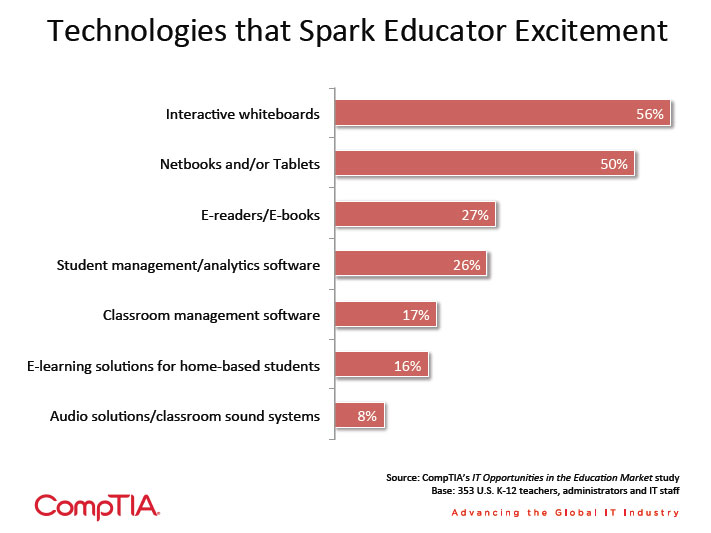
Section 2 of this report series goes into much greater detail about the types of technologies that K-12 and higher education respondents are using today and plan to use or not use in the coming 12 months.
And yet, generally speaking, attitudes toward the use of technology — both emerging and conventional solutions — remain quite positive among educators. More than three quarters (78%) of K-12 and higher education respondents said that the use of technology has had a positive impact on education processes, student performance and general results. Among early adopters of technology, a full 92% credited technology for fts positive impact on education, a sentiment that ran high across the gamut of different types of schools by size and type.

Both K-12 (63%) and higher ed (55%) respondents ranked improving student performance as the No. 1 demand driver for technology. Among higher education respondents, two other demand drivers stood out: boosting technical capabilities and improving data security. At the K-12 level, other factors behind the purchase and implementation of technology were more student-focused: Nearly half want technology to help them track data that informs them of student performance over time, while 39% are interested in solutions that allow them to have a better handle on academic project activity.
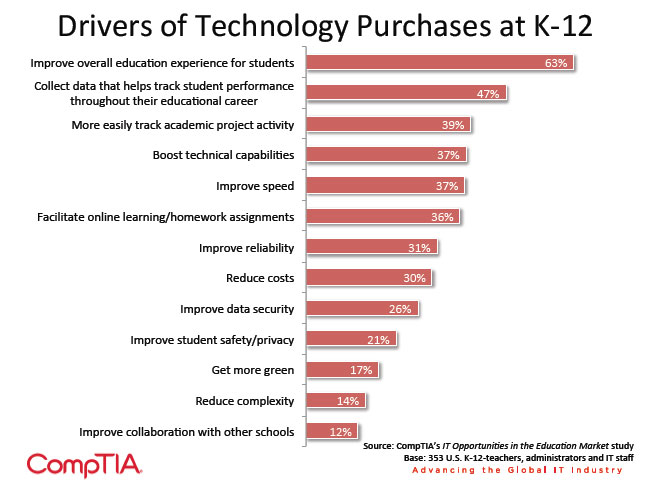
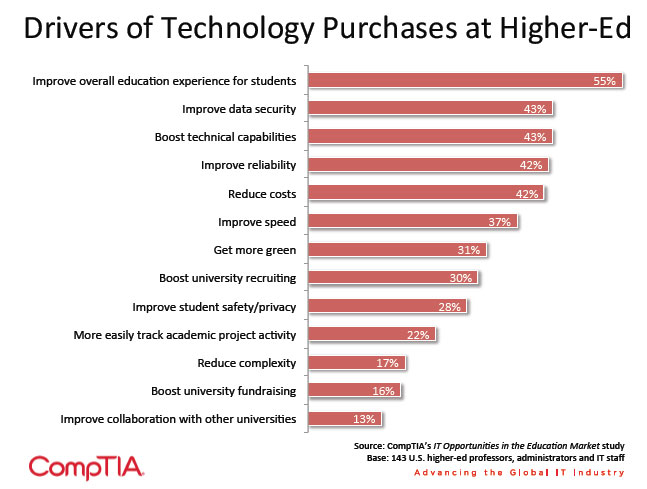
CompTIA's four-part report series, IT Opportunities in the Education Market, provides insights into the education market's use, consumption and purchase plans for technology, with the goal of outlining the tech industry opportunity from the perspective of actual educators. In this, Section 2 of this series, we look at the patterns of technology usage and adoption among K-12 schools and higher education institutions. It is important to note the sheer variation among schools. Their operating budgets, student numbers and general attitudes about the role of technology in the educational process run the gamut. The study identifies a number of commonalities as well as differences in which technologies are being used or not used across this broad ecosystem. One size definitely does not fit all.
Technology is pervasive in today's classrooms and school administrative offices. This report section examines the usage of conventional types of IT systems, as well as assessing adoption of both education-specific software and hardware and emerging technologies such as tablet devices and smart phones.
First off, let's take a look at technology usage in the K-12 classroom. As to be expected, some of the most longstanding, traditional types of technology have near-universal usage rates in the classroom. Projectors and A/V equipment, printers/scanners and desktop PCs round out the top 3 types of technology deployed in the K-12 classrooms today. What will be most interesting to watch is the future trajectory of desktop PC usage as laptops, tablets and other portable devices gain more of a stronghold in the classroom.
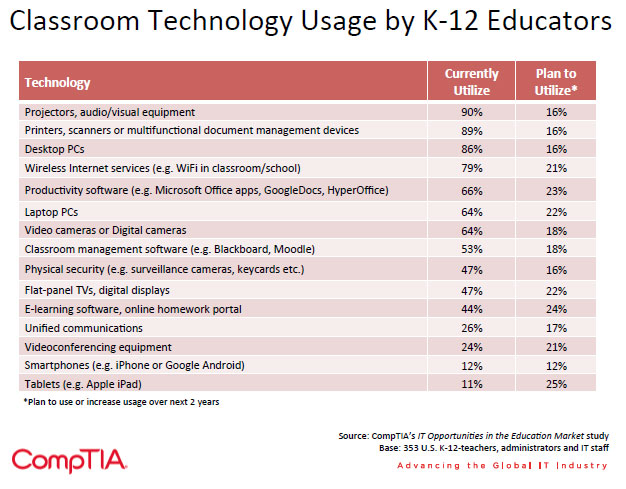
Nearly two-thirds of K-12 schools are using laptops in the classroom today, with another 18% planning to adopt them in the coming 12 months. It's difficult to believe that classrooms will maintain concurrent stables of upgraded desktops and laptops — at least not per individual student. The high incidence of wireless network access in the classroom — 79% currently have it — also suggests that mobile devices are becoming and will continue to be the primary computing tools for students and teachers.
But as we have seen this past year, laptops are not nearly the only road to mobility. The hottest devices on the market today arguably are tablets, along with smart phones such as Apple's iPhone and Google's Android. Penetration of those two categories into the K-12 classroom thus far has been weak with a whopping 68% of teachers saying they have no plans at all to add tablets and 74% eschewing any introduction of smart phones into the classroom. And yet those general numbers don't tell the full tale. For example, among schools with operating budgets in the highest categories ($25M-S99.9M and SIOOM+), a third of each group plans to bring tablet devices into the classroom in the next 12 months. Likewise, half of respondents who said that technology has had a significantly positive impact on education overall are currently using tablets in the classroom and plan to do so next year as well.
Smart phones represent a whole other animal. The wisdom of using them in the classroom is certainly debatable; the basic question being, Are students benefiting educationally from having mobile access or distracted by it? So far, it would appear that teachers are cautious about using smart phones in class (although among those with the most positive view of technology's impact, 45% are already using smart phones in the classroom). But consider the following from a recent survey by Speak up 2010, which found that 4 in 10 high school students and a third of middle school students currently own smart phones and the numbers are only rising. It would seem incumbent on educators to find a way to embrace these devices and integrate them into the general learning process.
Furthermore, at a time when school budgets are painfully tight, 67% of parents in the Speak up 2010 survey (which polled 300,000 students, 43,000 parents, 35,000 teachers, 2,000 librarians and 3,500 administrators from over 6,500 private and public schools) said that they were willing to buy their children a mobile device (smart phone or tablet) for school the schools allowed it. Parents were most interested in enabling students to access online textbooks. No question that such a model presents issues around security and equity among students that would need to be addressed, but the idea of sharing the pain financially in order to further the use of the latest technologies in the classroom isn't a bad one.
Beyond devices, there are some other newer technologies finding their way, albeit slowly, into today's schools. Unified communications, an amalgam of technologies that integrates voice and data for more seamless communication and collaboration, is at play in a quarter of today's schools. Interestingly, a third of schools with an operating budget on the smaller side ($5M-$24.9M) are using some form of unified communications in class today, compared with 22% of heavier-pocketed institutions. This might reflect the relative ease with which smaller institutions can roll out pilot tests of technology and can pull the plug with few consequences if the trial doesn't work out. Generally speaking though, demand for unified communications is clearly there, with 4 in 10 schools across all segments planning to add this technology to the mix in the next 12 months.
Video cameras and digital cameras also have become useful teaching tools in the classroom, with three-quarters of teachers using them. What percentage of these devices are personally owned by the teachers or school-issued is unclear, but Ws unlikely many are being sourced through the conventional IT channel. And yet that is a potentially missed opportunity for solution providers. With the increasing convergence of consumer products and corporate IT systems, the potential exists for a solution provider specializing in networking services to sell digital cameras as an add-on to the larger deal.
Outside of the classroom, technology also plays a critical role in the administrative functions of K-12 schools. Several types of systems not found in the classroom are in widespread usage in school offices, including student information systems and databases and the back-office infrastructure of servers, networking equipment and storage.
The arrival of cloud computing is destined to shake up the general IT infrastructure landscape, including the systems housed within school systems' back offices. The adoption of cloud computing services will enable schools to move off their in-house hardware, trading a capital expenditure for an operational expense — a positive development for districts grappling with budget shortfalls and freezes on buying new equipment. Channel companies selling into the education space in the coming year will want to seriously consider promoting the cloud computing option when the time comes to replace in-house IT equipment. The cost savings argument is powerful and the market is there: A third of schools today are evaluating cloud computing solutions, while 1 in 5 are already utilizing them in some form, based on this study.

Taking a look further into the data for administrative use of technology and, not surprisingly, certain disparities exist between schools with different operating budgets. For example, nearly 8 in 10 of the highest budget schools are using videoconferencing systems in their administrative offices, while 4 in 10 of the fiscally smaller school administrations do so. It's likely that the schools with the fatter budgets also have more physical buildings in their district and could be spread out geographically, hence the true usefulness of deploying videoconferencing to collaborate remotely. For a school with a small budget, located in a single building or cluster of buildings, this technology is simply too costly and not necessary.
Physical security is another technology challenge for school administrators. Increasingly, sophisticated video surveillance and other security measures are put in place to protect students and staff, buildings and infrastructure. Three-quarters of schools with the largest operating budgets currently use physical security technologies, compared with half of the schools with budgets less than $5M per year. This likely reflects the fact that the school systems with the largest budgets also tend to have a higher number of students and many buildings with multiple entries and exits to protect. Physical security technology represents yet another example of the convergence trend between corporate IT and other forms of electronics. Security, both physical and electronic, is one of the major convergence crossroads. For more on how security concerns impact schools, their staff and students, turn to Section 3 of this report series, where findings focus on computer security as it relates to data and other electronic information.
Beyond the conventional forms of computing systems and solutions found in schools today, there are a growing number of technologies aimed specifically at the education market, tools such as classroom-management software and e-learning solutions that facilitate online homework and accommodate students out for extended sick periods. Tablets, because they are so new, are also lumped into this category. Additionally there is a raft of emerging technologies like cloud computing that the industry as a whole is adopting or evaluating. These technologies are also applicable to the education vertical.
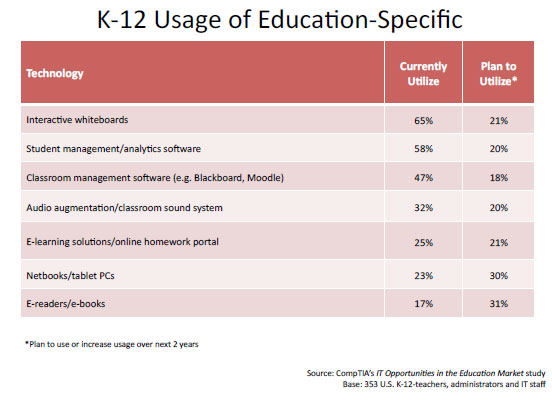 Analyzing the use of education-based and emerging technologies, it is evident that the larger the school budget, the greater the adoption. For example, among schools
with an operating budget of more than $100M, 74% currently use e-learning/online homework portal solutions compared with just 34% of schools with a budget less than $5M.
Analyzing the use of education-based and emerging technologies, it is evident that the larger the school budget, the greater the adoption. For example, among schools
with an operating budget of more than $100M, 74% currently use e-learning/online homework portal solutions compared with just 34% of schools with a budget less than $5M.
Classroom management software is popular among teachers, not surprisingly. Two- thirds of teachers said they use or plan to use this software, which features vendor brands such as Blackboard and Moodle, among others. This software provides teachers with monitoring and control of students as they work on computers in the classroom. Students and teachers can collaborate online effectively with these software systems, both on a one-to-one and a one-to-many basis.
Classroom management software is just one example of the types of vertical applications that solution providers looking to crack the education market need to become proficient in. Increasingly the education process is mirroring the way that corporate businesses function: Remote access capabilities, teacher and student mobility and a 24/7 type of environment. Fifty-nine percent of schools are already set up with wireless networks in classrooms, dorms and other buildings, with another 12% planning to light up next year.
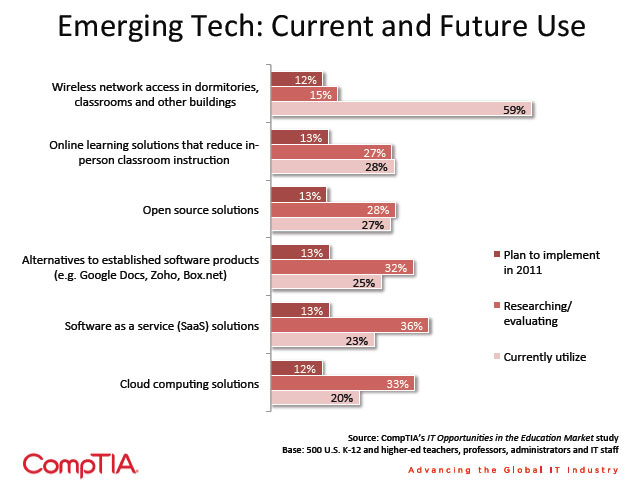
The cost of IT is a huge issue for schools and is likely to be a driving factor in their experimentation and usage of some of the emerging technologies on the market today. For example, software as a service applications (SaaS) and cloud computing allow schools to access software and computing resources more affordably, in some cases for free, over the Internet. Thirty-seven percent of K-12 schools with an operating budget more than $100 are using SaaS applications today. At the higher education level, 1 in 4 one in four institutions have adopted cloud computing services, or plan to in next 12 months. Among schools that consider themselves early adopters of technology, a third are using cloud today compared with 14% of middle adopters and 10% of late adopters.
Colleges and universities are often considered to reside on the more advanced side of the technology spectrum. And that's certainly true. If one trend stands out when comparing higher education technology usage to K-12 is that adoption rates for certain technologies are greater at the post-secondary school level. The other major variable at the higher education level is the role of individual students, a population sophisticated about technology and demanding in terms of features, functions and availability.

As shown in the chart above, for example, adoption rates for tablet devices and smart phones, while still at the bottom of the usage chart (just as with K-12 respondents), are nonetheless higher for the post-secondary grouping. One in 3 are using these two devices in the classroom today. This likely reflects the fact that portability, especially among instructors in higher education, is such a critical issue across a college campus environment. Think about it: In a given day, few professors teach in the same classroom or even building, the opposite of most K-12 teachers, and instead shuttle between different classrooms, buildings and their individual offices.
Mobility's importance also extends to the student population, which demand access to data and applications for their classroom work anywhere/anytime. Hence the ubiquity of wireless networks in higher education, today commonly established infrastructure in university dormitories, classrooms and common spaces. According to a new report from Compass Intelligence, an IT consultancy and market research firm, K-12 and higher education institutions will spend $5.7 billion on wireless services and equipment, growing at a compound annual rate of 5.2 percent through 2014.
The balancing act between strained school budgets and the goal of implementing technologies that promote student experience and results and accomplish long-term educational goals will clearly impact technology adoption and usage decisions — both current and future. And yet there are some hopeful indicators. Consider a few:
Technology has been an integral part of the school experience since the early days of overhead projectors and other basic audio/visual equipment to the growth of 1980s' computer labs lined with ubiquitous Apple 11S to todaVs proliferation of myriad technologies inside every classroom.
To succeed as a vendor or channel organization selling into education or any other vertical market, it's critical to understand pain points specific to that sector, along with the client's goals for running a more successful business and serving their own core customers better.
In education, there is an array of "customers" to consider if you are in the business of running a school or university (parents, teachers, alumni, donors), but none more paramount than the students themselves. Findings from the CompTIA study reflect students' relevance and the importance educators place on technology's role in serving the student population. Case in point: the No. 1 catalyst behind today's technology purchases is the desire to improve the overall educational experience for students. This objective ranks first across both K-12 and higher education, though slightly more so at the K-12 level, where 63% of educators ranked student experience No. 1 compared with 55% of college/university educators.
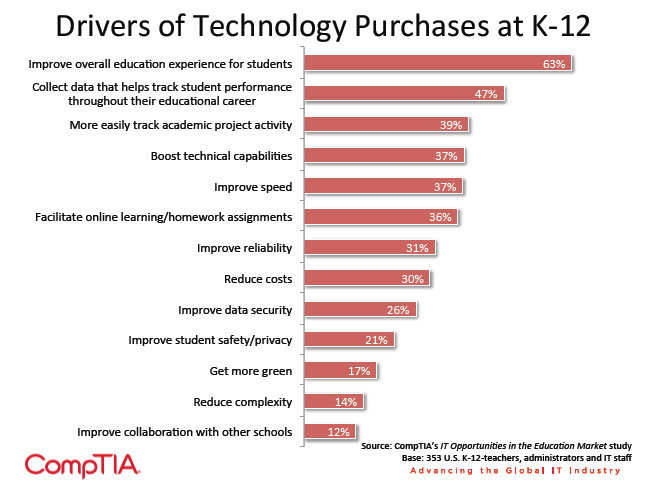 And yet having such a clear-cut demand driver does not always translate into an easier sales strategy for the channel. Think about it: If you are a solution provider or vendor trying to sell into the education market, how do you correlate your technology solutions to improved student educational performance?
And yet having such a clear-cut demand driver does not always translate into an easier sales strategy for the channel. Think about it: If you are a solution provider or vendor trying to sell into the education market, how do you correlate your technology solutions to improved student educational performance?
That's a tough one unless you can produce specific metrics linking the deployment and use of a technology to the rise or fall of student performance. Teachers are more likely in a position to provide this kind of information than the sellers of the technology.
Instead, a more successful sales approach to the K-12 space might be to tackle some of the other top priorities driving their demand for technology. For example, educators today are looking for ways to more easily track students' academic progress electronically with software that allows for data collection that can be analyzed mier time. Half of K-12 teachers specifically are asking for this capability. It allows them to remain on top of dips and rises in a student's performance, just as CEOs use analytics software and dashboards to monitor the real-time progress of their business, spot positive and negative trends and course-correct on the fly.
Teachers also want to put technology to use that helps them track projects, again similar to what goes on in the private corporate sector. Among schools with the largest operating budgets last year (>$100 million), for example, 61% wanted project-based technology solutions. This likely reflects the added complexity larger schools experience with respect to student population size, the number of projects underway at any given time, cross-departmental implications and the need to collaborate across more than one physical property.
Software that addresses these needs opens a great avenue for today's solution providers to access the education market successfully. Classroom management tools such as Blackboard and Moodle, among others, as well as staple project management platforms represent a stable of solutions that the channel can take to educators today. Each of these solutions will need to be integrated with a school's conventional IT systems, which means additional services dollars for providers.
K-12 educators are also looking for more general operational improvements that technology can bring: More reliability (31%) and faster speeds (37%). These demands reflect a desire to boost operational efficiency, which administrators and teachers likely will acknowledge helps them succeed with the core mission — improving student education. Operational efficiency also helps with another technology driver: Cutting costs, which nearly a third of K-12 educators cited. Four in 10 of small schools ($5M to "4.9M), where budgets are being decimated, are seeking greater reliability via technology, for example.
From the perspective of educators at the higher ed level, similar priorities to K-12 drive demand, but there is slightly more clamoring for technologies that improve data security and boosting technical capabilities in general. Data security makes sense, with much larger student populations, larger campuses and systems that are tied to alumni networks and university fundraising applications.
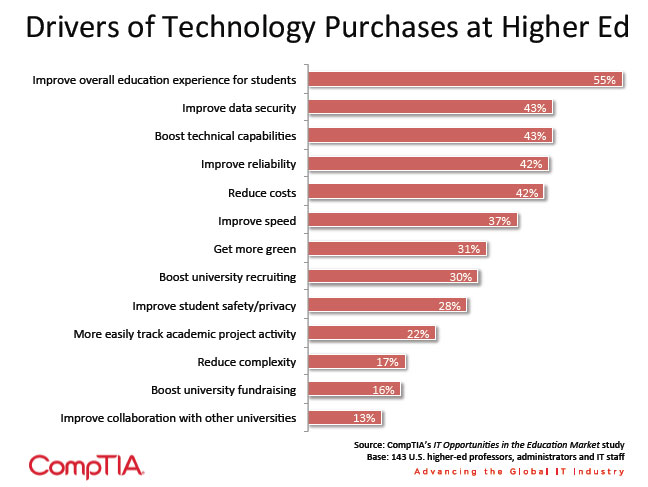 Higher education is a competitive business, too. The endless quest to attract and enroll the best and brightest students is a massive undertaking at many institutions. It's an endeavor educators believe can be furthered by the use of technology. Nearly a third of college educators cited boosting university recruiting as a demand driver. That includes 42% of colleges with the smallest enrollments (<200 students) and 40% of those with the smallest annual operating budgets (<$5M).
Higher education is a competitive business, too. The endless quest to attract and enroll the best and brightest students is a massive undertaking at many institutions. It's an endeavor educators believe can be furthered by the use of technology. Nearly a third of college educators cited boosting university recruiting as a demand driver. That includes 42% of colleges with the smallest enrollments (<200 students) and 40% of those with the smallest annual operating budgets (<$5M).
And just as the Internet has enabled small businesses to look bigger and compete effectively with much larger companies, it is also leveling the playing field for educational institutions. With an online presence, Web marketing and the use of social media, smaller schools now have greater reach and a wider footprint — at an affordable cost to find new students.
By far, educators believe the most formidable roadblocks to technology adoption are those related to the almighty dollar. This isn't surprising. State budgets especially have taken a hit over the last several years, with shrinking allocations for all educational expenses, including technology. Budget cutbacks, initial costs and freezes on capital expenditures topped the list of obstacles to tech adoption cited by respondents, eclipsing the next closest hurdle — training and user adoption issues — by more than double at the very closest.
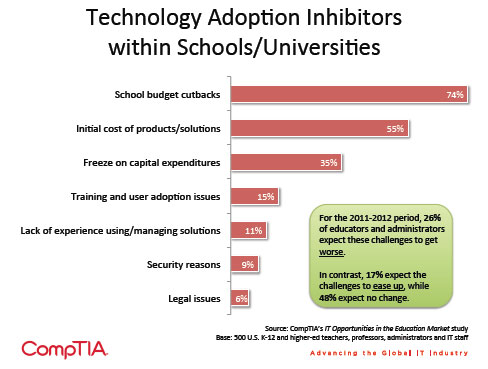 A not-insignificant percentage of K-12 classroom teachers, college professors/instructors and administrators from both groups are dubious that the technology floodgates will open up in the next 12 months.
A not-insignificant percentage of K-12 classroom teachers, college professors/instructors and administrators from both groups are dubious that the technology floodgates will open up in the next 12 months.
In fact, 26% of teachers and 31% of administrators from both institutional levels said they expected the barriers to technology adoption to get worse in the coming year.
This likely reflects budgetary realities. Schools, especially publicly funded institutions, are typically slow bureaucracies even in the best of times. And while the general economy is slowly improving, recent educational budget cuts are unlikely to yield quickly, hence the pessimism.
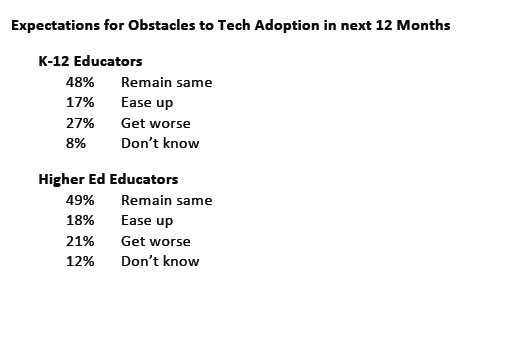 Today's educators demand technology for a number of reasons, from improving the learning experience to creating a more efficient environment for teachers and administrators to perform their duties. And yet despite compelling reasons for wanting to implement technology, not everpne has purchasing power or equal influence over what gets implemented within their school. And even those with purchasing power are still constrained by budgets.
Today's educators demand technology for a number of reasons, from improving the learning experience to creating a more efficient environment for teachers and administrators to perform their duties. And yet despite compelling reasons for wanting to implement technology, not everpne has purchasing power or equal influence over what gets implemented within their school. And even those with purchasing power are still constrained by budgets.
To sell into the education market, it is critical to know who holds the purse strings and also which parties tend to be important influencers, typically the two constituencies closest to the students: teachers and in K-12 mainly, parents, and how the budget cycle works.
 Similar to selling into government, the public education sector resides on various types of budgeting cycles, with many schools buying technology only at one or two prescribed times per year. Solution providers that specialize in this market have gotten to know that budget schedule and also become experts in federal programs such as E-Rate that provide discounts to assist most U.S. schools and libraries obtain affordable telecommunications and Internet access — all done through technology providers.
Similar to selling into government, the public education sector resides on various types of budgeting cycles, with many schools buying technology only at one or two prescribed times per year. Solution providers that specialize in this market have gotten to know that budget schedule and also become experts in federal programs such as E-Rate that provide discounts to assist most U.S. schools and libraries obtain affordable telecommunications and Internet access — all done through technology providers.
Understanding the labyrinth of budget schedules, federal dollars available for school technology and other legislation gives solution providers in this market a leg up.
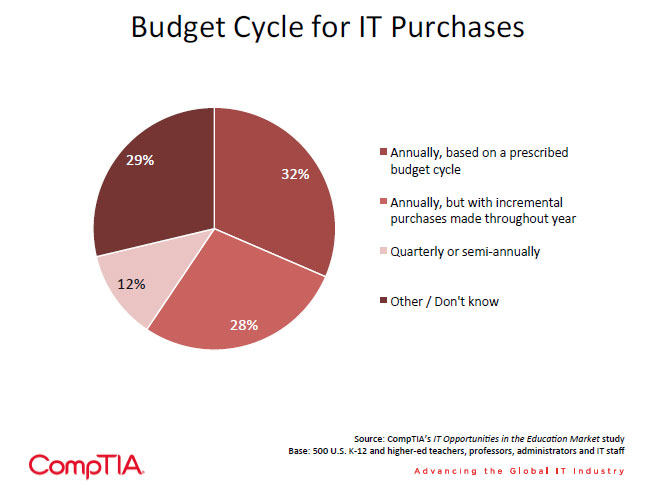
While budgets remain tight, educators at both the K-12 and higher ed level are continuing to demand the purchase and implementation of technology — both as a strategic move to further objectives such as improving student performance or teacher capabilities or as cost-savings measure to help bring more efficiencies back into the organization.
To be successful selling into the education market, solution providers must remain cognizant of both these goals: strategic spending and operational savings. With that message in mind, the sales process can be targeted to the specific needs of various types of schools. Large universities prize data security and will be open to discussions around security software, systems and services; K-12 schools are looking for ways to better track student performance through software, for example. Understanding demand drivers is an essential ingredient to tackling this sector.
More than ever, technology is playing a mission-critical role in classrooms, school administrative offices, university dormitories and lecture halls. The stakeholders to keep happy are many: Teachers, professors, office staff, administrators, IT workers and students rely on various technology solutions to accomplish day-to-day duties and facilitate longer-term initiatives.
With reliance, however, comes expectation. Educators are counting on technology to work as it is billed, reliably and consistently. In this section of the CompTIA IT Opportunities jn the Education Market study, we report and analyze the satisfaction levels that educators (teachers, administrators, instructors, school support staff) disclose regarding the technologies they use today.
Generally speaking, educators at both the K-12 and higher education level report high levels of satisfaction with the conventional computer systems they use, including PCs, laptops, printers, software, networking equipment, Internet solutions, mobile phones and other forms of IT. Nearly 60% of the total K-12 and higher ed population report being satisfied with the technology they use in the classroom, while just 7% were flat-out dissatisfied. Sixty-two percent of educators expressed approval with the technology at use in their schools' administrative offices, much of it similar to what is in the classroom at its core, but also including such things as back-office software, databases and analytics.
Remote access and mobility solutions, increasingly critical in the education market to enable such solutions as online learning and homework portals, also got high marks from educators, with more than half (56%) reporting to be satisfied.
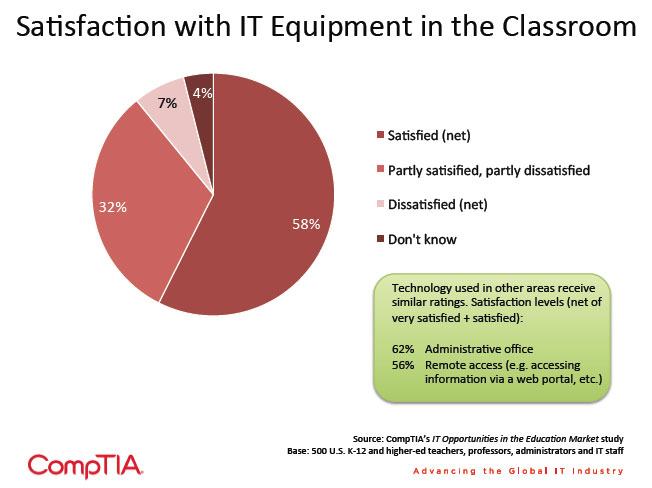 While satisfaction levels in aggregate are quite positive, there is a slight pattern of difference between K-12 educators and those in higher education. Consider the following:
While satisfaction levels in aggregate are quite positive, there is a slight pattern of difference between K-12 educators and those in higher education. Consider the following:
Upon analyzing satisfaction levels across the various types of schools (K-12 and higher ed), the CompTIA study finds that 49% of educators in schools with the smallest operating budgets (<$5 million annually) said they were satisfied with their classroom IT equipment, which at first blush looks like a relatively positive result. As it turns out, 49% renders this school grouping the least content with their technology when compared with their counterparts. For example, 60% of educators in schools with between $5 million and $24.9 million said they were satisfied with their technology. Similarly, 60% of those in schools with the largest coffers (>$100 million) also reported satisfaction. The fact that half of the smallest schools expressed at least some dissatisfaction with their technology is not altogether surprising, however. Technology is costly, both to buy and maintain and to upgrade. Smaller overall budgets often restrict the number of in-house IT staff employed to manage technology. Less funding also puts limits on technology purchase choices, causing schools to buy used or hold onto older equipment longer, a situation ripe for performance declines sure to irritate users.
These micro-sized schools, budget-wise, also reported the least satisfaction with their remote access technologies; 49% are content versus more than two-thirds of educators at schools with operating budgets greater than $50 million. On the flip side, educators from schools identifying as early adopters of technology are the most upbeat about their IT equipment. A full 83% said they were satisfied with their classroom technology, for example, compared with just 1 in 4 of those from late adopter schools. It makes sense. Odds are good that the early adopter schools are sporting the most up-to-date technology, while the late adopters are not.
Just as the best teachers don't let straight-A students become complacent in their academic efforts, educators still voice plenty of room for improvement in their technology — regardless of how well performs today. In a number of areas, including cost to purchase and maintain, reliability, ease of use and customer service, both K-12 and college educators agreed that improvements could be had.
The age of IT equipment is the area most cited as for improvement potential. This should strike solution providers and vendors as a major opportunity area. Old computers justifiably put a dent in satisfaction ratings, frustrating users and creating inefficiencies. The tricky part for the channel though is how to sell new equipment to schools with cash-strapped budgets: The sobering fact is that vast majority of educators in the study also said that the cost to purchase IT was another major area for improvement.
And yet this seeming Catch 22 between the desire for new equipment and the dearth of money to buy is likely to be addressable as cloud computing makes its way into today's education market. Educators looking for the same capabilities in their technology without the expense of buying the equipment and managing it in-house are likely to be attracted to a new model in which they pay for IT as a service, making it an operational expense managed by a third-party.
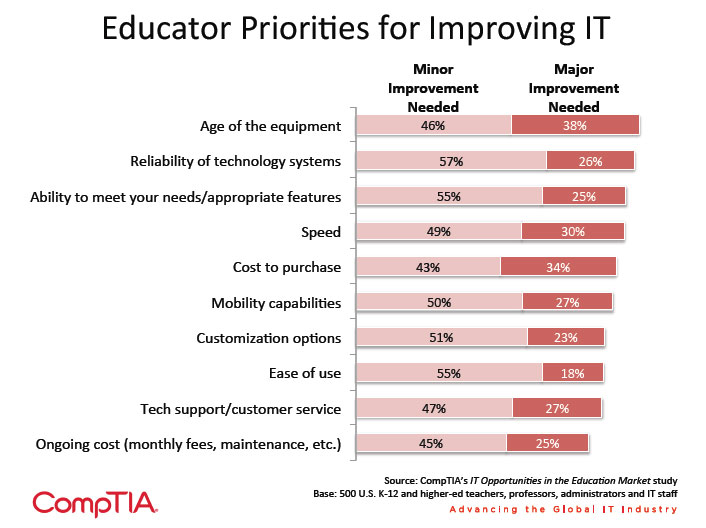 Forrester Research predicts the worldwide market for cloud computing will reach $241 billion by 2020. Now is the time to dive in. The education market today is experiencing what could be the perfect storm for cloud adoption with aging equipment and strained budgets. Furthermore, educators in the CompTIA study also pointed out reliability as an improvement area, along with the ability for technology to meet their specific needs with appropriate features. Cloud computing allows for more flexibility around change management and real-time upgrades, so new features and capabilities can be added more easily on the fly than they can to an on-premise packaged application, for example.
Forrester Research predicts the worldwide market for cloud computing will reach $241 billion by 2020. Now is the time to dive in. The education market today is experiencing what could be the perfect storm for cloud adoption with aging equipment and strained budgets. Furthermore, educators in the CompTIA study also pointed out reliability as an improvement area, along with the ability for technology to meet their specific needs with appropriate features. Cloud computing allows for more flexibility around change management and real-time upgrades, so new features and capabilities can be added more easily on the fly than they can to an on-premise packaged application, for example.
Other areas for improvement have implications for training. Nearly 3 in 4 of all educators said technology could be easier to use. Among schools with the largest operating budgets (>SIOO million) more than a quarter cited ease of use as a major improvement area. Appropriate end user training is one way to mitigate frustration with daily technology interactions and increase productivity. This is a significant services opportunity area for the channel.
Another strong indicator of satisfaction with a technology is investment plans. That is especially true with some of the newer technologies aimed at the education space, such as classroom management software, interactive whiteboards and even tablet devices.
The increased investment in technologies designed specifically for educational use indicates a degree of satisfaction based on the educators' current experience with these solutions. It also is likely that a portion is deciding to try these technologies for the first time. Either way, the opportunity for the channel is there. One of the keys to selling into the education sector is to be versed in the technologies that are driving advancements in the classroom.
Lastly, one of the other areas of concern for educators of all stripes is security. Online bullying, data breaches and other threats are a reality for schools today and the CompTIA study bears out the apprehension that some educators and staff feel. Forty-five percent of college educators and 39% of K-12 said they were concerned about IT security in general, but surprisingly, 29% of K-12 educators reported no concern over security issues. The lack of concern either indicates confidence in their security software protection or lack of understanding about current threats.
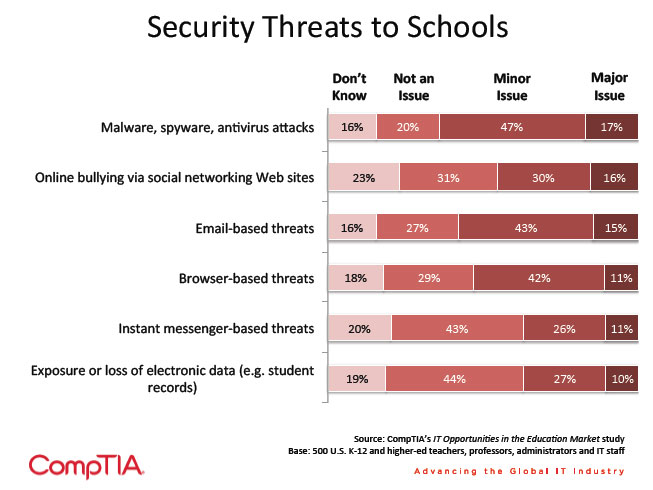 With the exception of online bullying, which appears to be a primarily a K-12 problem, educators at the college level report more impact from security infringements across the board than K-12 educators, particularly among the IT staff at those institutions. Nearly 70% of higher ed personnel said their schools were impacted by email-based threats in the last 12 months versus 53% of K-12 educators. There's a similar disparity with browser-based threats, with 66% of higher ed respondents seeing an impact compared with 47% of K-12. When it comes to malware, spyware and other virus-related issues, more than three quarters of college educators said they'd been impacted, while 59% of K-12 folks did.
With the exception of online bullying, which appears to be a primarily a K-12 problem, educators at the college level report more impact from security infringements across the board than K-12 educators, particularly among the IT staff at those institutions. Nearly 70% of higher ed personnel said their schools were impacted by email-based threats in the last 12 months versus 53% of K-12 educators. There's a similar disparity with browser-based threats, with 66% of higher ed respondents seeing an impact compared with 47% of K-12. When it comes to malware, spyware and other virus-related issues, more than three quarters of college educators said they'd been impacted, while 59% of K-12 folks did.
With respect to online bullying, which takes place via social networking sites and email, half of K-12 educators reported it as impacting their schools in the last 12 months compared with 37% of those in higher education. From a channel standpoint, security — and raising satisfaction levels through protection and prevention — is another major opportunity area to pursue when selling into the education market.
Read more about The Business of Technology.
Tags : The Business of Technology